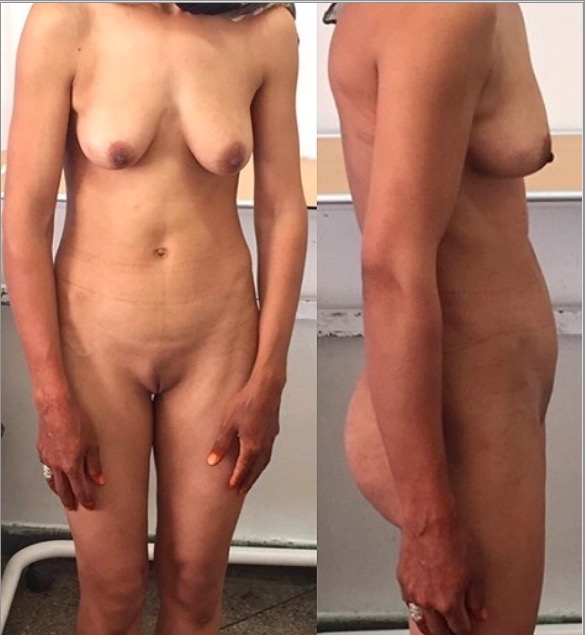Playlist
Show Playlist
Hide Playlist
Androgen Insensitivity Syndrome: Management and Case Study
-
Slides Androgen Insensitivity Syndrome.pdf
-
Download Lecture Overview
00:01 Let’s now talk about the management of androgen insensitivity. Remember that a gonadectomy needs to be performed. So here in the diagram, you see a uterus with an ovary. That’s not what we see in androgen insensitivity patient. Actually what we see is cryptorchid, testes that have not descended. 00:22 So, those testes are at increased risk of developing tumors and therefore need to be removed. 00:27 After the removal of those testes when growth has already achieved its maximal potential, hormone replacement or HRT is initiated depending on what gender the patient prefers to be. 00:39 If she prefers to be female, that replacement needs to have estrogen and progestin eventually. 00:46 If she would prefer to be male, then that patient should be given testosterone. 00:52 Remember that in the undervirilized male phenotype, that they can have a specific syndrome that’s called Reifenstein syndrome. I doubt that you’ll be tested on these patients. 01:03 But just for your information, these patients have partial androgen insensitivity syndrome. 01:08 They could benefit from high doses of DHT or dihydrotestosterone or testosterone to help with their virilization process. Remember these patients may sometimes require plastic surgery to correct their gynecomastia. Remember that gynecomastia is breast development. 01:26 If these patients prefer to identify as male, that tissue needs to be removed. If they prefer to identify as female, the tissue can be left in place and vaginal dilation can occur with dilators or surgical options. 01:41 Lastly, don’t forget these patients do need psychological counseling and support as finding out that their genetic sex and their phenotypic sex are not the same can be very distressing. 01:53 Let’s now review the lecture. Remember that CAIS or complete androgen insensitivity syndrome looks phenotypically female. PAIS or partial androgen insensitivity syndrome has a range of presentations and can go from a virilized female to an unvirilized male. Testosterone levels are the same as they should be in a normal male. Remember, the problem is the receptor, not the production of sex steroids. Gonadectomy of the testes is critical to decrease the risk of cancer with cryptorchidism. X-linked inheritance is actually the most common mode of inheritance but it can be de novo mutations. So, if there is X-linked inheritance, prenatal screen of relatives is possible. 02:41 Let’s now review a case. A 15-year old young woman presents for consultation. 02:49 She’s a G0 meaning she’s never been pregnant. She presents to your pediatrician’s office with primary amenorrhea. You astutely observe her tall stature which is an indication, remember, of adrenal insufficiency. She’s Tanner stage V for breasts but Tanner Stage I for pubic hair which is the lowest stage. So, she has no pubic hair. You send sequencing on her androgen receptor because you remembered this lecture and you find that she has complete AIS. What is your next step? How can she start a family one day? I’m going to give you a moment to think about those questions before I go to the response. One, if she has complete androgen insensitivity, remember that her testes will be undescended and she’s at increased risk for cancer. So, she should be referred for gonadectomy and psychological support. If a gonadectomy occurs, remember that she will require hormone replacement therapy. Again, you need to explain to these patients that gender has nothing to do with the karyotype or anatomy and reassure her that she’s a woman if she chooses to be one. 04:04 Gender is what you believe yourself to be and has nothing to do with actual biology. 04:10 Explain that she does not have a uterus. Therefore, she cannot carry a fetus as she would normally if she had a uterus. Explain that she has testes so she does not produce eggs. 04:21 Those testes will have been removed. Her options for starting a family include adoption, egg donation with another person, or a gestational surrogate carrying that ensuing pregnancy. 04:34 If a patient with partial androgen insensitivity identifies as male, a sperm donor is another option for that patient as their testes will need to be removed and they unlikely have normal spermatogenesis.
About the Lecture
The lecture Androgen Insensitivity Syndrome: Management and Case Study by Lynae Brayboy, MD is from the course Normal Puberty and Disorders of Sexual Development. It contains the following chapters:
- Androgen Insensitivity Management
- Case Study
Included Quiz Questions
Which of the following is NOT a part of the management of androgen insensitivity syndrome in an individual who identifies as a man?
- Estrogen supplementation
- Gonadectomy
- Plastic surgery
- DHT or testosterone in an under virilized man
- Psychological support
What is the purpose of gonadectomy in cryptorchid testis seen in patients with androgen insensitivity syndrome?
- Prevent malignant transformation of the cryptorchid testis
- Prevent torsion of the cryptorchid testis
- Cessation of production of testosterone
- Cosmetics
- Prevent ischemia and necrosis of the cryptorchid testis
Customer reviews
5,0 of 5 stars
| 5 Stars |
|
5 |
| 4 Stars |
|
0 |
| 3 Stars |
|
0 |
| 2 Stars |
|
0 |
| 1 Star |
|
0 |




